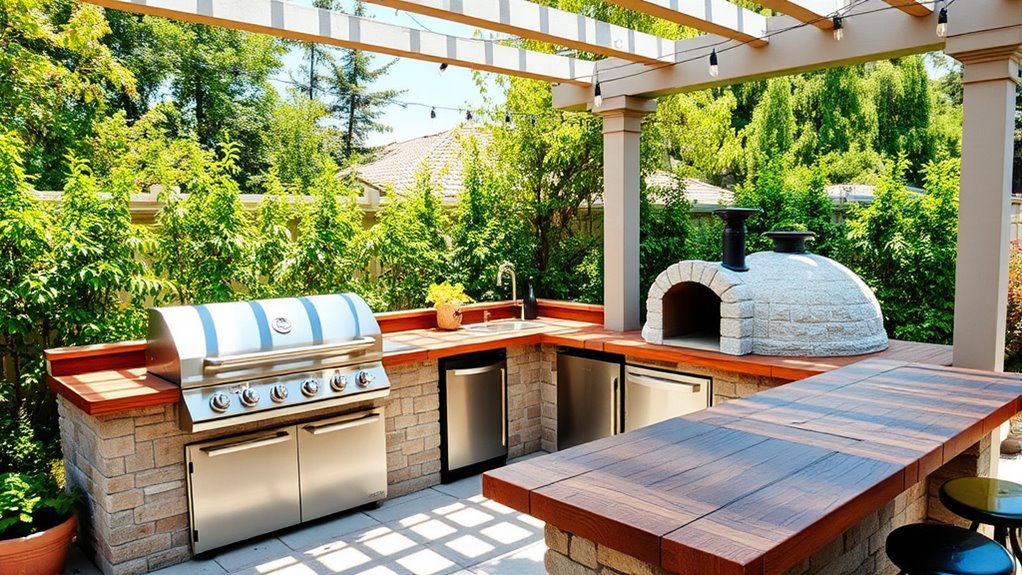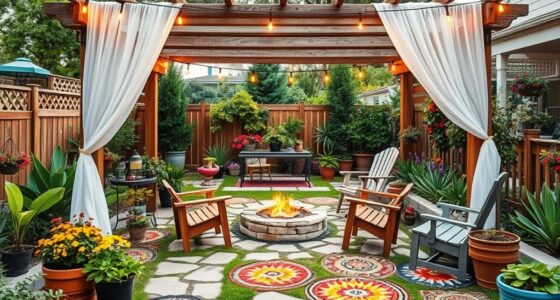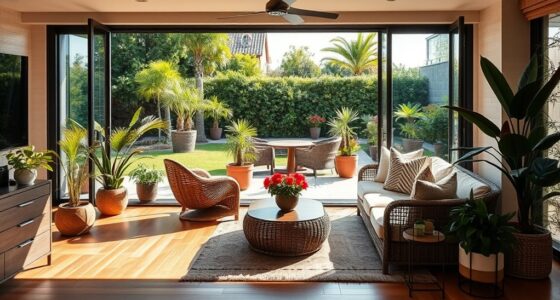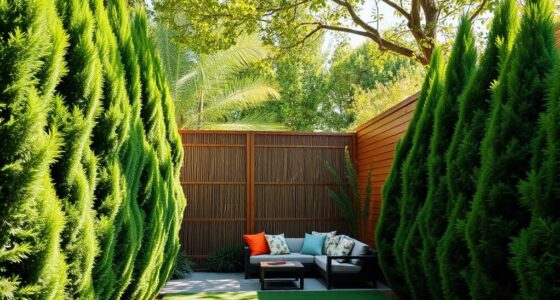When planning your backyard cooking space, start by placing the grill away from your house for safety and good airflow. Choose weather-resistant materials like granite or concrete for countertops that can handle heat and moisture. Design your layout with the work triangle in mind—grill, prep, and sink—while keeping traffic flow smooth and safe. Adding stylish yet functional elements, like outdoor planters and organization hooks, enhances both appearance and usability. Continue exploring to build a durable, efficient outdoor kitchen you’ll enjoy for years.
Key Takeaways
- Choose a safe, well-ventilated location away from the house and traffic zones.
- Select weather-resistant, durable countertop materials like granite or concrete.
- Design for efficiency with a logical layout, including proximity of grill, prep area, and storage.
- Incorporate safety features such as proper placement, built-in drainage, and fire-resistant surfaces.
- Match materials and design elements to your backyard style for a cohesive, attractive look.
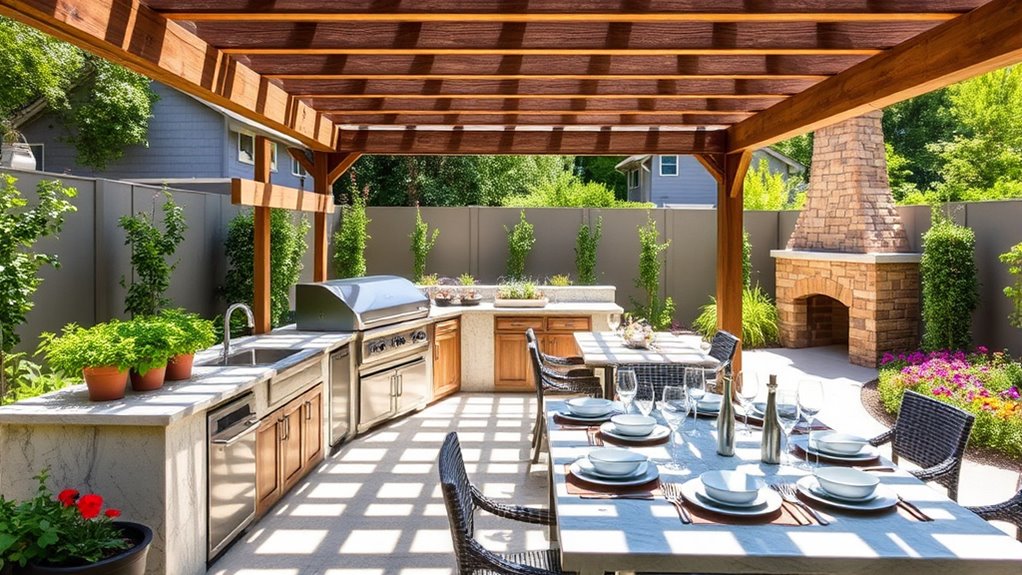
Creating an outdoor kitchen is a great way to extend your living space and enjoy cooking in the fresh air. When planning your layout, one of the most vital decisions revolves around grill placement. You want your grill to be conveniently located for easy access yet positioned safely to prevent accidents or smoke from bothering your guests. Typically, placing the grill slightly away from the house or under a shaded area ensures good ventilation and keeps smoke away from your indoor spaces. Think about traffic flow too—your grill should be easily reachable from your main prep and serving zones without creating congestion or hazards. Positioning it near your countertop workspace allows you to move seamlessly between grilling and preparing food, streamlining your cooking process and making everything more enjoyable.
Place your grill safely away from the house for good ventilation and easy access.
Speaking of countertops, choosing the right materials is essential for durability and style. You’ll want surfaces that can withstand the elements—think weather-resistant materials that resist moisture, fading, and heat. Popular options include natural stone like granite, which offers both strength and a luxurious look, or concrete countertops that can be customized in terms of color and finish. For a more affordable choice, tile or stainless steel countertops work well, especially since they’re easy to clean and maintain. When selecting countertop materials, consider how you’ll use your outdoor kitchen. If you plan on doing heavy chopping or prepping, opt for a sturdy, heat-resistant surface that won’t crack or warp over time. Additionally, think about incorporating features like built-in drainage or sealed surfaces to make cleaning easier and prevent water from pooling.
Another key aspect to keep in mind is how your countertop materials complement your overall design. You want your outdoor kitchen to blend seamlessly with your backyard aesthetic, whether it’s modern, rustic, or Mediterranean-inspired. Combining durable materials with attractive finishes can elevate your space while providing practicality. Remember, the layout should promote efficiency—your grill, prep area, sink, and storage should form a logical work triangle, minimizing unnecessary movement. Incorporating aesthetic hooks and wall organization solutions can also help keep your tools and accessories accessible and your space tidy. Furthermore, exploring vetted outdoor planters can add greenery and a touch of nature to your cooking area, enhancing the overall ambiance.
Ultimately, thoughtful grill placement and selecting suitable countertop materials lay the foundation for a functional, attractive outdoor kitchen. These choices influence safety, ease of use, and the overall ambiance of your backyard cooking haven. When you carefully plan these elements, you’ll create a space that’s inviting, efficient, and built to last, making outdoor cooking more enjoyable for years to come.
Frequently Asked Questions
What Are the Best Materials for Outdoor Kitchen Countertops?
When choosing outdoor countertop materials, you want durability and weather resistance. Opt for stone like granite or soapstone, as they stand up well to outdoor elements and are easy to clean. Concrete is also a good option, especially with sealed finishes to boost weather resistance. Avoid materials that crack or stain easily. Your goal is to select weather-resistant surface options that guarantee your outdoor countertop remains functional and attractive over time.
How Can I Incorporate Weather-Resistant Lighting Into My Outdoor Kitchen?
To incorporate weather-resistant lighting, you should choose fixtures like waterproof string lights and solar-powered fixtures. Install waterproof string lights along your cabinetry or pergolas to create a cozy ambiance, and opt for solar-powered fixtures to save energy and reduce wiring. Make sure all lights are rated for outdoor use, and secure them properly to withstand weather conditions. This way, your outdoor kitchen remains functional and inviting, day or night.
What Are Cost-Effective Options for Building an Outdoor Kitchen?
Building an outdoor kitchen on a budget might seem like a Herculean task, but with DIY projects and smart budget tips, you can turn it into an achievable feat. Focus on simple, cost-effective materials like concrete blocks or repurposed furniture. Shop sales and plan your design to avoid unnecessary expenses. You’ll create a functional, stylish space without breaking the bank, proving that great outdoor kitchens are within everyone’s reach.
How Do I Maintain Outdoor Kitchen Appliances in Different Climates?
To keep your outdoor kitchen appliances in good shape across different climates, you should focus on regular appliance cleaning and seasonal maintenance. Clean grills, countertops, and appliances after each use to prevent buildup. In colder or wetter climates, cover or store appliances during off-seasons, and check for rust or corrosion. Proper upkeep helps extend their lifespan and keeps your outdoor cooking space functional and beautiful year-round.
What Safety Features Should I Include in My Outdoor Cooking Area?
Imagine your outdoor kitchen as a fortress of flavor, where safety is your shield. To protect your culinary haven, include fire safety features like a fire extinguisher nearby and a shut-off valve. Secure storage keeps knives and flammable items out of reach, preventing accidents. These safety features act as your guardians, ensuring your outdoor cooking adventure stays enjoyable, worry-free, and as inviting as a warm, glowing hearth.
Conclusion
Now that you’ve mastered the basics, you’re ready to create a mesmerizing, convenient outdoor culinary corner. With careful planning, clever choices, and a touch of creativity, your backyard becomes a bustling, beautiful breeze of BBQs and bites. Picture perfect pizza nights, sizzling steaks, and sweet summer socials—all in your stunning, functional space. So, step outside, start shaping your sanctuary, and savor the sensational, summery setting you’ve skillfully set!
